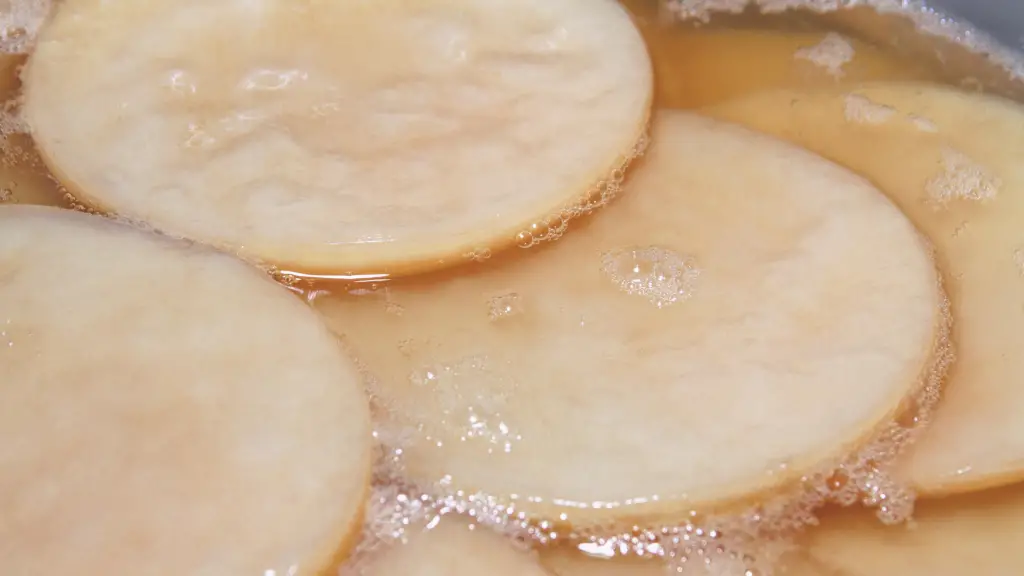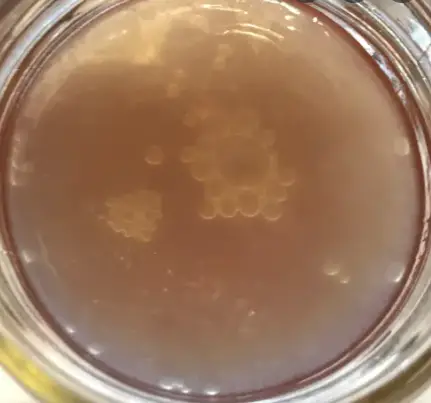SCOBY is probably the most iconic part of kombucha. Its unappetizing look, especially when floating in the jar is its own double-edged sword, making people curious and ick at the same time. SCOBY is so fascinating that sometimes new brewers wonder if it’s possible to make kombucha without a SCOBY.
In this post, learn how SCOBY works, why most brewers prefer to use it on their brews, and why they never run out of SCOBYs once they start brewing. Once you discover the fascinating way of making SCOBY, you’ll surely consider eating it too despite its icky look.
What is a SCOBY?
SCOBY stands for Symbiotic Colony of Bacteria and Yeast. It is a gelatinous film formed when the yeast converts sugar into alcohol. It may look soft but it is rubbery. Under the lens of a microscope, you will see tons of yeast and bacteria on its surface, which are responsible for the fermentation of the sweet tea.
Brewers often place a SCOBY in a new batch of tea and end up having more SCOBY at the end of the fermentation. As long as there’s sugar in the tea, the yeast and bacteria will create new layers of SCOBY. That’s the reason why your friends and family are giving their SCOBYs as gifts.
The lifespan of SCOBY can last for six months to a year, depending on how you prepare and store it. It needs a sterile environment to be safe from contamination and cold temperatures to keep the yeast and good bacteria in slumber or inactive.
You may see brewers add SCOBY to new brews but it is NOT the main driver of fermentation. Instead, it only amplifies the fermentation, protects the brew, and makes it more flavorful.
Q: Do you need SCOBY to make kombucha?
A: Yes, you need SCOBY to make kombucha to improve its flavor and make that distinct kick that makes kombucha unique. However, you can brew kombucha without a SCOBY. It only houses the yeast and bacteria that are responsible for fermentation.
The key ingredient of a kombucha brew is the starter kombucha culture which is the unflavored kombucha from a previous brew or an unflavored bottle of store-bought kombucha. Think of SCOBY as a reinforcement to the yeast and bacteria in the starter tea.
With an abundant number of strong yeast and bacteria from the starter culture and SCOBY, there will be more microorganisms that will convert sugar into alcohol and acid. They will also help improve the carbonation of the drink, which makes the final kombucha a delectable fizzy drink.

Benefits of brewing kombucha with a SCOBY
Some people may argue that SCOBY is not necessary for kombucha fermentation but doing so may have a few caveats. Placing a SCOBY in a new brew is not only reinforcement to the yeast and bacteria in the starter tea but also provides the following benefits:
Faster Fermentation
The idea of placing a starter tea and SCOBY in a jar of sweet tea is to feed the good bacteria and yeast and let them do work. If you only put a starter tea, there may not be enough yeast or bacteria that will turn sugar into alcohol and acid which leads to longer fermentation.
Instead of one week, you may end up extending the first fermentation for another 2 to 3 days just to achieve your desired kick. With the reinforcement yeasts and good bacteria in the SCOBY, you’ll achieve the ideal taste of kombucha in a shorter time.
Better carbonation
The carbonation in kombucha is formed when the bacteria release carbon dioxide as it converts sugar into alcohol. So, with only a small amount of yeast and bacteria that comes from the starter tea culture, you can’t expect a soda-like fizzy kombucha.
Aside from ideal temperature, inadequate carbonation is the main reason why most brewers call some brews weak not only because they are too sweet but also because they lack fizziness. The additional yeast and bacteria that stay on the surface of a SCOBY will compensate for the demand for more carbonation.
The SCOBY that floats in a jar also helps serve as a seal that will protect the brew from further exposure to pathogens. It is the reason why if there’s mold contamination you’ll first notice it on the SCOBY.
Improved protection against contamination
One of the reasons why the first kombucha fermentation is the most vulnerable phase to contamination is because of its developing acidity. The acids are only formed when the yeast and bacteria start feeding on sugar. The more acetic acid is released into the brew, the more it is capable of killing pathogens.
Mold pathogens cannot survive in a brew that’s too acidic and contains tons of yeast and good bacteria that can outnumber them. The strength of the starter culture and SCOBY, brewing temperature, and the sugar in the tea work together in boosting the health of the yeast and good bacteria for optimal sugar conversion.
SCOBYless kombucha: How to make kombucha without a SCOBY?
If you don’t have a SCOBY or love the taste of kombucha but still have some trust issues with the look of SCOBY, here’s a beginner-friendly way to brew your SCOBYless kombucha:
Materials:
- 7 cups of water.
- Temperature strip.
- 1 cup of starter tea (unflavored kombucha tea).
- 4 bags of black tea.
- 64g sugar.
- Pot.
- Fermentation jar.
- Coffee filter or cheesecloth.
- Rubberbands
- Swing-top glass bottles
- Kombucha heating pad (optional).
Directions:
1. Boil a pot of water(7 cups). Set it aside, steep the tea and mix the sugar. Set it aside and let it cool down for 5 to 15 minutes.
2. Pour the tea and the starter tea into the fermentation jar. Some brewers may encourage you to add vinegar at this step to prevent contamination but it’s best to not do it.
Note: Only use filtered water in fermenting your ginger bug and soda. Tap water contains chlorine that can kill all the beneficial microbes that do the actual fermentation process.
3. Cover the fermentation jar with a coffee filter or cloth and secure it with a rubber band. This barrier will allow the air to flow while protecting the brew from contaminants.
4; Attach a temperature strip to the jar to easily monitor the brewing temperature of your kombucha. ideally, 75 F is the best brewing temperature for kombucha but you’ll still get a good brew if it falls between 75 F and 80 F.

5. Place the fermentation jar in a clean and dry place, away from trash bins and moldy areas. To know more about the best parts of the house to brew kombucha, check our separate blog here.
6. Brew the kombucha for 7 to 10 days. you may occasionally check the flavor on the 6th to 8th day if it already suits your palate. The longer you brew, the more acid will be released into the brew which means it will become sourer. In some cases, you will also notice a thin film on top of the brew which is the SCOBY.
7. Once you achieved your desired flavor, you may stop the fermentation by transferring the brew to smaller bottles in preparation for the second fermentation. You may keep a few bottles of unflavored kombucha to serve as your starter tea for the next brew.
The second fermentation of kombucha will be for flavoring and making the brew carbonated. You may check how the second fermentation works on our kombucha brewing guide here.
Frequently Asked Questions (FAQs)
Can you eat the SCOBY in kombucha?
Yes, you can eat the SCOBY and add it to your meals or smoothies. It has a more intense kombucha flavor and a gummy texture. As long as it is uncontaminated, SCOBY is safe to eat. Most brewers love its tangy taste that adds character to their usual meals. Check how you can consume SCOBY here.
Is a SCOBY alive?
Yes, SCOBY that is stored properly in the fridge or submerged in a brew is alive. However, just like other living organisms, they also age. A SCOBY is dead when it is no longer converting sugar into acid and alcohol and the brew stays too sweet after 5 to 7 days.
How healthy is kombucha?
Kombucha has a controversial set of health benefits that are slowly being embraced by modern medicine. Animal studies and testimonies from avid kombucha drinkers share the following kombucha health benefits:
- Helps treat cancer.
- Aids in managing Type 2 diabetes.
- Reduce risks of heart disease.
- Has antibacterial properties.
- Aids in weight loss.
- Contains antioxidants.
- Improves digestion.
- Boosts skin health.
- Reduce liver toxicity.
- Improves inflammation and alleviates depression.
Is it OK to drink kombucha every day?
Yes, kombucha is safe to drink every day as long as you only consume the daily recommended intake of 12 oz. consumed three times a day. Going beyond that limit may lead to side effects like nausea or bloating.
Who should not drink kombucha?
There are a few groups of people who should not drink kombucha, including pregnant women, young children, and those with weakened immune systems. Pregnant women should avoid kombucha because it contains small amounts of alcohol and caffeine.
Young children should not drink kombucha because of the risk of infection. Those with weakened immune systems should also avoid kombucha because it contains live bacteria that could cause infections.
Is kombucha a SCOBY?
SCOBY is cellulose that forms during the fermentation of kombucha. It contains yeast and good bacteria that converts sugar into acetic acid ethanol while releasing carbon dioxide during the process.
Kombucha can be formed through the combination of SCOBY and starter tea. They are not the same thing since they are the product of each other.
